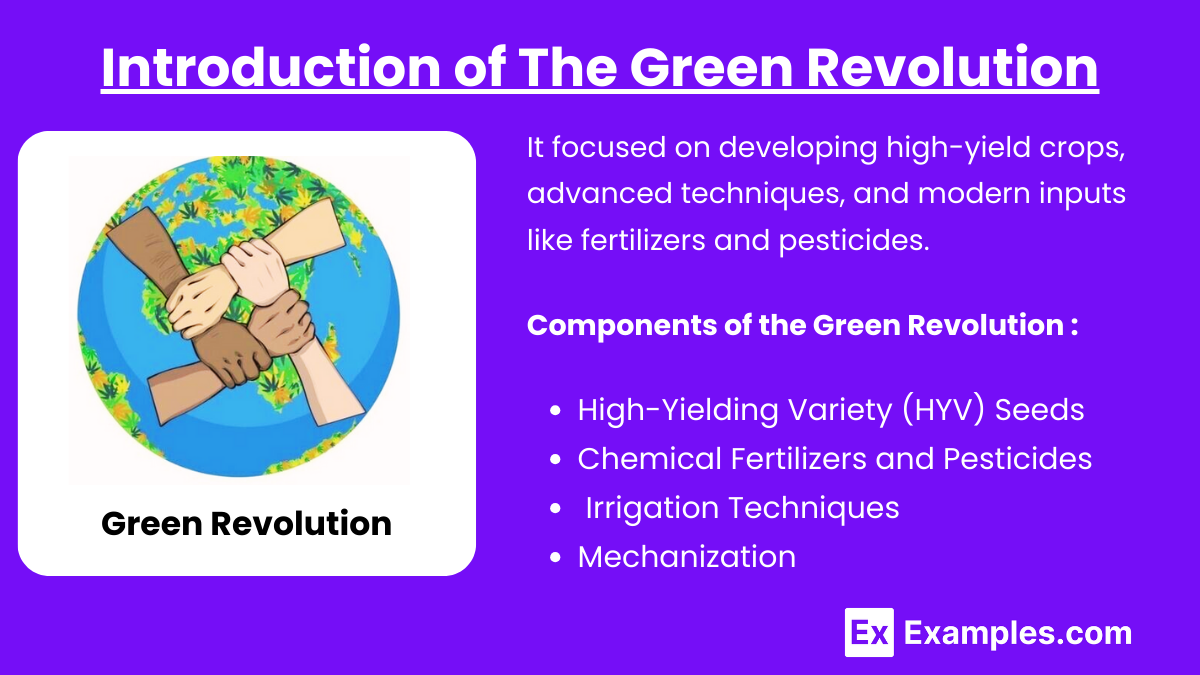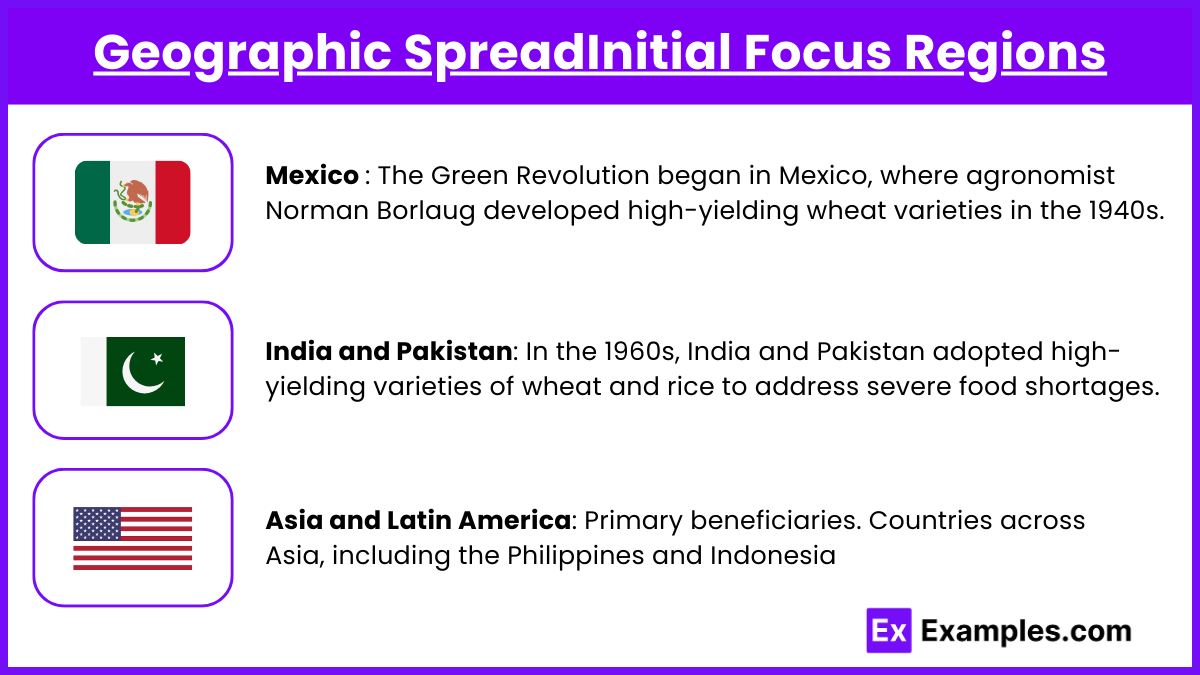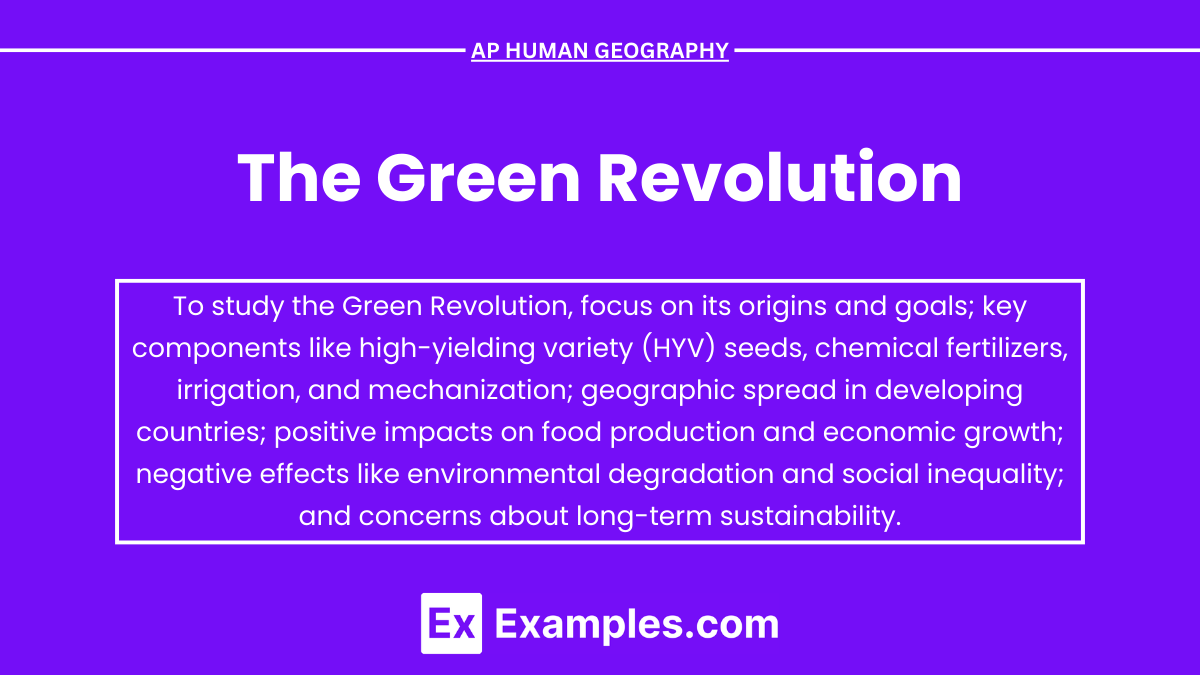The Green Revolution refers to a period of agricultural transformation that began in the 1940s and extended into the late 20th century, dramatically increasing food production worldwide. By introducing high-yielding crop varieties, advanced irrigation techniques, chemical fertilizers, and pesticides, it aimed to combat hunger and support growing populations, especially in developing countries. In AP Human Geography, understanding the Green Revolution is crucial for analyzing the impacts of technological innovation on agricultural practices, population growth, and socio-economic development.
Learning Objectives
By studying “The Green Revolution” for AP Human Geography, you should aim to understand the technological innovations and agricultural practices that defined this period. Learn how these changes increased food production and affected population growth, urbanization, and economic development in various regions. Analyze the environmental and socio-economic consequences, including issues of sustainability and inequality. Be prepared to apply these concepts to case studies, connect them to broader human geography themes, and evaluate both the positive and negative impacts on societies worldwide.
Introduction of The Green Revolution

The Green Revolution refers to a period of agricultural transformation that began in the 1940s and gained momentum during the 1960s and 1970s. It involved the development and dissemination of high-yielding crop varieties, advanced agricultural techniques, and modern inputs like chemical fertilizers and pesticides. The movement significantly increased food production worldwide, particularly in developing countries, and had profound social, economic, and environmental impacts.
Key Components of the Green Revolution
1. High-Yielding Variety (HYV) Seeds
- Definition: Genetically improved seeds designed to produce more grain per plant.
- Examples: New strains of wheat, rice (e.g., IR8 rice variety), and maize.
- Characteristics:
- Shorter and sturdier stalks to support heavier grain loads.
- Increased responsiveness to fertilizers.
2. Chemical Fertilizers and Pesticides
- Fertilizers: Synthetic nitrogen, phosphorus, and potassium compounds to enhance soil fertility.
- Pesticides: Chemicals used to combat pests and diseases affecting crops.
- Impact: Boosted crop yields but led to environmental concerns like soil degradation and water pollution.
3. Irrigation Techniques
- Development of Extensive Irrigation Systems: Dams, canals, and tube wells.
- Purpose: Provided reliable water supply, enabling multiple cropping seasons per year.
- Challenges: Overuse of groundwater resources and salinization of soils.
4. Mechanization
- Introduction of Machinery: Tractors, harvesters, and threshers.
- Effect: Increased efficiency and reduced labor costs but contributed to rural unemployment.
Geographic SpreadInitial Focus Regions

- Mexico: Early successes with wheat under the guidance of agronomist Norman Borlaug. The Green Revolution began in Mexico, where agronomist Norman Borlaug developed high-yielding wheat varieties in the 1940s. His efforts, supported by research institutions and government initiatives, led to a dramatic increase in wheat production
- India and Pakistan: Significant adoption in the 1960s to combat food shortages. In the 1960s, India and Pakistan adopted high-yielding varieties of wheat and rice to address severe food shortages. With support from Borlaug and international organizations, farmers received training on modern agricultural practices.
- Asia and Latin America: Primary beneficiaries. Countries across Asia, including the Philippines and Indonesia, and various nations in Latin America, became primary beneficiaries of the Green Revolution
Impacts of The Green Revolution
Positive Impacts
- Increased Food Production
- Yield Enhancement: Wheat and rice yields doubled or tripled in some regions.
- Food Security: Helped avert famines in countries like India and Pakistan.
- Economic Growth
- Agricultural Prosperity: Boosted incomes for farmers who adopted new technologies.
- Industrial Development: Stimulated growth in related sectors like fertilizer and machinery production.
- Technological Advancement
- Modernization of Agriculture: Shift from subsistence to commercial farming.
- Innovation: Encouraged further research in agricultural science.
Negative Impacts
- Environmental Degradation
- Soil Depletion: Overuse of chemical fertilizers led to nutrient imbalances.
- Water Issues: Contamination from agrochemicals and depletion of water tables.
- Loss of Biodiversity: Monoculture practices reduced genetic diversity.
- Social Inequality
- Economic Disparities: Benefits accrued mainly to wealthy farmers who could afford inputs.
- Land Tenure Issues: Smallholders and tenant farmers often marginalized.
- Rural Unemployment: Mechanization reduced the need for agricultural labor.
- Sustainability Concerns
- Dependency on Chemicals: Increased resistance in pests and diseases.
- Long-Term Viability: Questions about the sustainability of high-input farming systems.
Examples
Example 1. Transformation of Wheat Production in Mexico
In the 1940s and 1950s, Mexico underwent a significant agricultural transformation as a result of the Green Revolution. Under the guidance of agronomist Norman Borlaug and the Rockefeller Foundation, high-yielding, disease-resistant dwarf wheat varieties were developed. These new strains could produce more grain per plant and were less susceptible to rust diseases. The widespread adoption of these wheat varieties, combined with improved irrigation and fertilizer use, enabled Mexico to shift from being a wheat importer to achieving self-sufficiency by the late 1950s. This example illustrates the diffusion of agricultural innovations and their impact on national food security.
Example 2. The Punjab Region’s Agricultural Boom in India
In the 1960s and 1970s, India faced severe food shortages and was on the brink of famine. The Green Revolution was implemented primarily in the Punjab region, where the government introduced high-yielding varieties (HYVs) of wheat and rice, along with subsidies for fertilizers and irrigation infrastructure. The result was a dramatic increase in grain production; wheat yields in Punjab doubled between 1965 and 1972. This agricultural boom turned India into a grain exporter and highlights how technological advancements can rapidly enhance food production. However, it also led to environmental issues like soil depletion and water scarcity, emphasizing the need for sustainable practices.
Example 3. Introduction of IR8 Rice in the Philippines
The International Rice Research Institute (IRRI) in the Philippines played a pivotal role in the Green Revolution by developing IR8, a high-yielding rice variety. Introduced in 1966, IR8 was capable of producing more grains per plant and had a shorter growing cycle, allowing for multiple harvests per year. Filipino farmers who adopted IR8 experienced significant increases in rice yields, which helped alleviate hunger and boosted the country’s economy. This example demonstrates the role of scientific research in agricultural development and its direct impact on improving food availability in a developing nation.
Example 4. Limited Impact in Sub-Saharan Africa
Despite successes elsewhere, the Green Revolution had a limited impact in sub-Saharan Africa. Factors such as diverse agro-ecological zones, lack of infrastructure, political instability, and limited access to capital hindered the adoption of Green Revolution technologies. For instance, many of the high-yielding crop varieties were not well-suited to African soil and climate conditions. Additionally, the high cost of fertilizers and irrigation systems was prohibitive for smallholder farmers. This example underscores the challenges of transferring agricultural innovations across different geographic and socio-economic contexts, highlighting the importance of considering local conditions in development initiatives.
Example 5. Environmental Degradation in Intensively Farmed Areas
In regions where the Green Revolution was most intensively implemented, such as parts of India and China, the overuse of chemical fertilizers and pesticides led to significant environmental degradation. Soil health deteriorated due to nutrient imbalances, and water sources were contaminated with agrochemicals. For example, in the Indian state of Haryana, excessive irrigation caused waterlogging and salinization of soils, reducing agricultural productivity over time. This example illustrates the unintended negative environmental consequences of the Green Revolution, emphasizing the need for sustainable agricultural practices that balance increased food production with environmental conservation.
Multiple Choice Questions
Question 1
Which of the following was a primary feature of the Green Revolution that significantly increased agricultural productivity in the mid-20th century?
A) The global transition from subsistence farming to commercial agriculture.
B) The development and adoption of high-yielding varieties (HYVs) of staple crops.
C) The introduction of genetically modified organisms (GMOs) into crop production.
D) The widespread implementation of sustainable organic farming practices.Answer:
B) The development and adoption of high-yielding varieties (HYVs) of staple crops.
Explanation:
The Green Revolution was marked by the creation and dissemination of high-yielding varieties (HYVs) of staple crops such as wheat, rice, and maize. These genetically enhanced strains were developed through selective breeding to produce more grains per plant, resist diseases, and respond better to fertilizers, leading to dramatic increases in crop yields.
- Option A is incorrect because while there was a shift towards more commercial agriculture, the primary feature was the introduction of HYVs.
- Option C is incorrect as GMOs became prominent during the “Gene Revolution,” which occurred later, not during the original Green Revolution.
- Option D is incorrect because the Green Revolution relied heavily on chemical fertilizers and pesticides, not on sustainable organic practices.
Question 2
One significant socio-economic impact of the Green Revolution in developing countries was:
A) A reduction in the income disparity between wealthy and poor farmers.
B) An increase in rural employment opportunities due to labor-intensive farming methods.
C) The exacerbation of social inequalities due to unequal access to Green Revolution technologies.
D) The empowerment of small-scale farmers through cooperative ownership of machinery.Answer:
C) The exacerbation of social inequalities due to unequal access to Green Revolution technologies.
Explanation:
The Green Revolution often widened socio-economic disparities. Wealthier farmers could afford the new HYVs, chemical inputs, and machinery, leading to increased productivity and profits. In contrast, poorer farmers frequently lacked the financial resources to invest in these technologies, which exacerbated existing inequalities.
- Option A is incorrect because income disparities generally increased, not decreased.
- Option B is incorrect as mechanization reduced the need for manual labor, leading to rural unemployment.
- Option D is incorrect because small-scale farmers often did not have access to or control over machinery, and cooperative ownership was not a widespread outcome of the Green Revolution.
Question 3
An environmental consequence directly associated with the practices of the Green Revolution is:
A) Enhanced soil fertility through traditional crop rotation techniques.
B) Decreased water pollution due to reduced use of agricultural chemicals.
C) Increased soil salinization and waterlogging from excessive irrigation.
D) Preservation of genetic diversity by cultivating multiple crop varieties.
Answer: C) Increased soil salinization and waterlogging from excessive irrigation.
Explanation:
The Green Revolution’s emphasis on irrigation to support HYVs led to environmental issues like soil salinization and waterlogging. Over-irrigation raised the water table, bringing salts to the soil surface and reducing soil fertility. This had detrimental effects on long-term agricultural sustainability.
- Option A is incorrect because the Green Revolution often neglected traditional practices like crop rotation.
- Option B is incorrect; the use of chemical fertilizers and pesticides increased, leading to more water pollution.
- Option D is incorrect as the focus on a few HYVs reduced genetic diversity, not preserved it.


